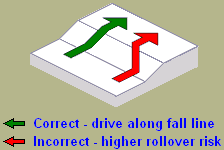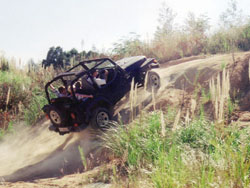|
|
 |
 |
 |
Off-Road Driving Techniques
Climbing Steep Slopes
|
|
For vehicles equipped with
low range gears,
climbing slopes of 40 degrees or more is easy. The power
of low range gearing ensures you get to the top, assuming
your tyres and the
surface of the incline provide you with with adequate
traction. Climbing a steep slope is a simple process:
select low-range second, drive straight up along the fall
line, making sure you don't loose traction because of
wheel-spin.
|
|
 |
 |
|
The fall line is a term borrowed from snowboarding,
and refers to the direct way down a hill - the path that
a ball rolls when you release it on a hill. Never cross
the fall line with your vehicle - you're risking a roll-over.
Always drive straight up or
drive
straight down
.
|
 |
|
Successful hill-climbing does require a bit of practice. All slopes are
different, and some require a bit of finesse. When the lip at the top of the
slope is really steep or has an axle-twister, drive up slightly faster to
allow the vehicle's momentum to help carry you over the top. Remember though
to go off the gas as soon as you reach the lip, as a heavy foot on this part
is bound to cause wheel-spin, leaving your car just below the top with no way
out other than reversing back down the hill.
|
Failed Climb |
|
If, for any reason, you get stuck on a hill, i.e. your engine stalled because
of too little thottle, or you just can't make the lip, you will need to reverse
your vehicle back down the slope. Although this may seem initially daunting, the
process is simple, safe and effective. Practice this technique in a controlled
environment to ensure you know what you're doing.
|
 |
| Engine running |
 |
|
First, make sure your left foor is on the clutch, and the right is firmly on the foot-brake.
Next, engage reverse gear, remaining in low range.
Look out your window and make sure that your wheels are straight. If they're turned you may find yourself turning sideways on the hill and risk a rollover!
Keep both hands firmly on the steering wheel!
Now release the clutch slightly ahead of releasing the foot-brake, and start reversing down the slope.
Look over your shoulder to ensure that you're driving straight down the hill, along the fall-line.
Keep going, not touching brake, clutch nor accelerator, and allow the compression of the engine to slowly bring you back down to level ground.
|
 |
| Stall (Engine not running) |
 |
|
First, make sure your right foot is firmly on the foot-brake.
Next, engage reverse gear, remaining in low range, then take your foot off the clutch.
Look out your window and make sure that your wheels are straight. If they're turned you may find yourself turning sideways on the hill and risk a rollover!
Keep both hands firmly on the steering wheel!
Now gently release the foot-brake.
The steepness of the slope may be get your engine running as is rolls back down. If so, skip the next step.
If your vehicle doesn't move, i.e. the vehicle is being held by the engine, briefly operate the starter, keeping your feet off the clutch and brake. This will start you moving back down.
Keep going, not touching brake, clutch nor accelerator, and allow the compression of the engine to slowly bring you back down to level ground.
|
 |
|
Practice this technique - its worthwhile and easy to learn. Remember that if
you can't make it all the way up a hill and spin your wheels excessively, you're
only wearing out your tyres and digging holes in the ground, making your next
attempt that much more difficult!
|
© 1998-2013 Martin Wittenburg and Michael Wittenburg. All rights reserved.
|